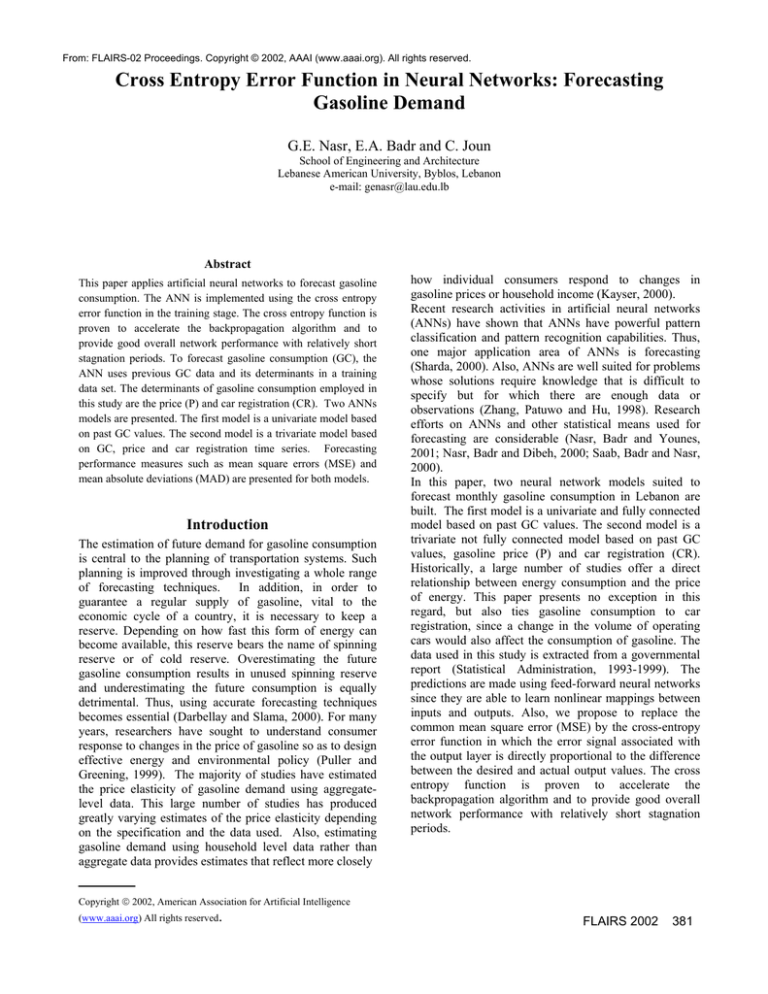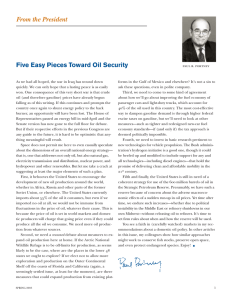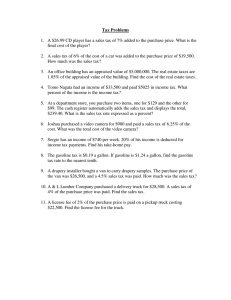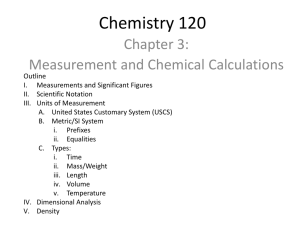
From: FLAIRS-02 Proceedings. Copyright © 2002, AAAI (www.aaai.org). All rights reserved.
Cross Entropy Error Function in Neural Networks: Forecasting
Gasoline Demand
G.E. Nasr, E.A. Badr and C. Joun
School of Engineering and Architecture
Lebanese American University, Byblos, Lebanon
e-mail: genasr@lau.edu.lb
Abstract
This paper applies artificial neural networks to forecast gasoline
consumption. The ANN is implemented using the cross entropy
error function in the training stage. The cross entropy function is
proven to accelerate the backpropagation algorithm and to
provide good overall network performance with relatively short
stagnation periods. To forecast gasoline consumption (GC), the
ANN uses previous GC data and its determinants in a training
data set. The determinants of gasoline consumption employed in
this study are the price (P) and car registration (CR). Two ANNs
models are presented. The first model is a univariate model based
on past GC values. The second model is a trivariate model based
on GC, price and car registration time series. Forecasting
performance measures such as mean square errors (MSE) and
mean absolute deviations (MAD) are presented for both models.
Introduction
The estimation of future demand for gasoline consumption
is central to the planning of transportation systems. Such
planning is improved through investigating a whole range
of forecasting techniques. In addition, in order to
guarantee a regular supply of gasoline, vital to the
economic cycle of a country, it is necessary to keep a
reserve. Depending on how fast this form of energy can
become available, this reserve bears the name of spinning
reserve or of cold reserve. Overestimating the future
gasoline consumption results in unused spinning reserve
and underestimating the future consumption is equally
detrimental. Thus, using accurate forecasting techniques
becomes essential (Darbellay and Slama, 2000). For many
years, researchers have sought to understand consumer
response to changes in the price of gasoline so as to design
effective energy and environmental policy (Puller and
Greening, 1999). The majority of studies have estimated
the price elasticity of gasoline demand using aggregatelevel data. This large number of studies has produced
greatly varying estimates of the price elasticity depending
on the specification and the data used. Also, estimating
gasoline demand using household level data rather than
aggregate data provides estimates that reflect more closely
how individual consumers respond to changes in
gasoline prices or household income (Kayser, 2000).
Recent research activities in artificial neural networks
(ANNs) have shown that ANNs have powerful pattern
classification and pattern recognition capabilities. Thus,
one major application area of ANNs is forecasting
(Sharda, 2000). Also, ANNs are well suited for problems
whose solutions require knowledge that is difficult to
specify but for which there are enough data or
observations (Zhang, Patuwo and Hu, 1998). Research
efforts on ANNs and other statistical means used for
forecasting are considerable (Nasr, Badr and Younes,
2001; Nasr, Badr and Dibeh, 2000; Saab, Badr and Nasr,
2000).
In this paper, two neural network models suited to
forecast monthly gasoline consumption in Lebanon are
built. The first model is a univariate and fully connected
model based on past GC values. The second model is a
trivariate not fully connected model based on past GC
values, gasoline price (P) and car registration (CR).
Historically, a large number of studies offer a direct
relationship between energy consumption and the price
of energy. This paper presents no exception in this
regard, but also ties gasoline consumption to car
registration, since a change in the volume of operating
cars would also affect the consumption of gasoline. The
data used in this study is extracted from a governmental
report (Statistical Administration, 1993-1999). The
predictions are made using feed-forward neural networks
since they are able to learn nonlinear mappings between
inputs and outputs. Also, we propose to replace the
common mean square error (MSE) by the cross-entropy
error function in which the error signal associated with
the output layer is directly proportional to the difference
between the desired and actual output values. The cross
entropy function is proven to accelerate the
backpropagation algorithm and to provide good overall
network performance with relatively short stagnation
periods.
Copyright 2002, American Association for Artificial Intelligence
(www.aaai.org) All rights reserved.
FLAIRS 2002
381
ANN Implementation
The study period spans the time period from 1993 to
1999. This period is used to train, test and evaluate the
ANN models. The training of the models is based on a
five-year training set, January 1993 to December 1997,
while the testing stage covers the period from January
1998 to December 1998. The evaluation stage covers the
period between January 1998 and December 1999. The
backpropagation algorithm is used for training since it is
proven to be highly successful in training of multilayered
neural nets for forecasting purposes.
The training of the network by backpropagation consists
of three stages:
• The feedforward of the input training pattern.
• The calculation and backpropagation of the
associated error.
• The adjustment of the weights.
Before applying the BPN algorithm, two steps are
required:
1. Initialize Weights: the weights from the input
layer to the hidden layer and the weights from the
hidden layer to the output layer are randomly
chosen to have values between –0.5 and 0.5.
2. Normalize data: The monthly data are normalized
in order to have values between 0.1 and 0.9. The
formula used is the following:
Data − Min * ( Hi − Lo) + Lo
Max − Min
Where:
Min = Monthly minimum data.
Max = Monthly maximum data.
Hi = 0.9 = Maximum value for the normalized data.
Lo = 0.1 = Minimum value for the normalized data.
The ANN models are implemented through an object
oriented programming method using Java programming
language. This program is used to train the net, test it and
evaluate it. The program involves many steps:
•
•
•
•
382
The weights are chosen randomly.
The minimum test error is initialized to the
maximum real value.
The training data set is passed to the network
more than once.
Backpropagation is performed using the cross
entropy error function as a stop criterion for
learning without exceeding the specified
maximum number of cycles or by using a fixed
number of epochs.
FLAIRS 2002
•
The network is tested using the testing data set
and the final performance measures of the
learning and testing set are computed. The test
error figures are also evaluated.
If the test error is less than the minimum test
error, the weights are saved and the test error
will be the minimum test error.
Otherwise, the net will be trained in a second
phase and new error measures are recorded.
The network is evaluated by calculating the
mean square error (MSE) and the mean absolute
deviation (MAD).
•
•
•
Cross Entropy Error Function
During the learning process, the ANN goes through
stages in which the reduction of the error can be
extremely slow. These periods of stagnation can
influence learning times. In order to resolve this problem
we propose to replace the mean square error (MSE) by
cross entropy error function. Simulation results using this
error function show a better network performance with a
shorter stagnation period.
The original MSE function for all training patterns is
given by
2
1 m
Em =
∑ (tk − y k )
m k =1
where t k represents the GC target value and y k is
the GC actual network value.
In the backpropagation model, we minimize the error
through iterative updates of weights for all training
patterns. In practice, this approach enables the network to
have a good performance but slow convergence to the
final outcome. Therefore, in order to accelerate the BP
algorithm and instead of minimizing the squares of the
differences between the actual and target values summed
over the output units and all cases, we propose the
following cross entropy error function to be minimized:
Em =
1 m
∑ [t k ln y k + (1 − t k ) ln(1 − y k )]
m k =1
To minimize the error Em, each weight wjk is updated by
an amount proportional to the partial derivative of Em
with respect to the weight. Using the mean square error
the partial derivative of Em with respect to wjk is
∂E m
= σ .( y k − t k ) y k (1 − y k ) ⋅ z j
∂w jk
By using the cross entropy error function, the partial
derivative of Em with respect to w jk becomes
∂E m
= σ ⋅ ( yk − tk ) ⋅ z j
∂w jk
Thus, the error signal, propagating back from each
output unit, becomes directly proportional to the
difference between target value and actual value
leading to a better network performance with a
shorter stagnation period.
Table 1: Model I Parameters and Errors
ANN model I - (GC)
Learning Rate (α)
= 0.5
Momentum (µ)
= 0.5
Slope (σ)
No. Inputs (Q)
=1
No. Hidden units
Error Function
Errors
=3
= cross entropy
MSE
= 793.7331
MAD
= 24.3257
=4
ANN Models
Model I
G C = f (G C )
Y1
Z0
Z1
O utput Layer
Z2
Z3
H id d e n La y e r
B ia s = 1
X0
B ia s = 1
X1
X2
X3
X4
G C (Q ty )
Figure 1: ANN Model I
Input Layer
200
GC (kiloTons)
Since present and future gasoline consumption (GC)
depends on previous gasoline consumption, a univariate
model is implemented. ANN model I requires previous
GC as data input patterns and has the layered structure
shown in Figure 1. This model is a fully connected model
since each input unit broadcasts its signal to each hidden
unit. The GC inputs represent four lagged gasoline
consumption parameters (a future value is dependent on
the last four month values). All input parameters are
selected following extensive testing by varying the values
of the learning rate, the momentum parameter, the slope
parameter and the number of input units. Parameter values
yielding lowest error figures are given in Table 1. The
error measures used in this study are the mean square
error (MSE) and the mean absolute deviation (MAD). The
corresponding prediction curve is shown in Figure 2.
150
100
50
0
61 63 65 67 69 71 73 75 77 79 81 83
Month
GC
Forecast
Figure 2. Actual and Forecasted Data using Model I
Model II
The second ANN proposed model is a trivariate model
which includes, in addition to previous GC data, the
price of gasoline (P) and car registration (CR) time series
as shown in Figure 3. Three P inputs (nodes 1-3) are
fully connected to two hidden nodes (1-2), Four GC
inputs (nodes 4-7) are also fully connected to two hidden
nodes (3-4) and three CR inputs (nodes 8-10) are fully
connected to two hidden nodes (5-6). Then all hidden
neurons are fully connected to the output unit. The
parameters yielding the lowest error values for this
model are given in Table 2. It is important to note that
the best trivariate model is achieved with four lagged GC
terms, while the Price (P) and Car Registration (CR)
have three lagged terms each. The results also show a
significant improvement in forecasting accuracy for this
trivariate model over the previous model. The predicted
and the actual curve of gasoline consumption for this
model are shown in Figure 4.
FLAIRS 2002
383
GC= f (P-GC-CR)
Y1
Z0
Z1
Z2
Output Layer
Z3
Z4
X5
X6
Z6
Z5
Hidden Layer
Bias = 1
X0
X1
X2
X3
X4
P
Bias = 1
X7
X8
GC(Quantity)
(Prices)
X9
X10
Input Layer
CR(Vehicules)
Figure 3: ANN Model II
Table 2: Model II Parameters and Errors
ANN model II - (P-GC-CR)
Learning Rate (α)
= 0.5
Momentum (µ)
= 0.5
Slope (σ)
=1
No. Inputs (P-GC-CR)
=3–4-3
No. Hidden units
=2-2-2
Error Function
= cross entropy
Errors
= 129.2828
MAD
= 9.509096
GC (kiloTons)
MSE
180
160
140
120
100
80
60
40
20
0
References
Darbellay, G.A.; and Slama, M. 2000. Forecasting the
short-term demand for electricity. Do neural networks
stand a better chance? International Journal of
Forecasting 16: 71-83.
Kayser, H. 2000. Gasoline demand and car choice:
estimating
gasoline
demand
using
household
information. Energy Economics 22: 331-348.
Nasr, G.E.; Badr, E.A.; and Younes, M.R. 2001. Neural
Networks in Forecasting Electrical Energy Consumption.
In Proceedings of the 14th International FLAIRS
Conference, 489-492. Menlo Park, Calif: AAAI Press.
Nasr, G.E.; Badr, E.A.; and Dibeh, G.L. 2000.
Econometric modeling of electricity consumption in
postwar Lebanon. Energy Economics 22 (6): 627-640.
Puller, S.; and Greening, L.A. 1999. Household
adjustment to gasoline price change: an analysis using 9
years of US survey data. Energy Economics 21: 37-52.
61 63 65 67 69 71 73 75 77 79 81 83
Month
GC
Forecast (cross entropy error)
Figure 4: Actual and Forecasted Data using Model II
Conclusion
This paper estimates gasoline consumption using artificial
neural networks models. Two models are built to forecast
future gasoline consumption. The first model is a
univariate model with four gasoline consumption (GC)
384
input units and is a fully connected model. The second
model is a trivariate partially connected model and has
past gasoline consumption, gasoline price (P) and car
registration (CR) as input units. To build the models, the
network is processed into three stages: the training stage,
the testing stage and the evaluation stage. The cross
entropy error function is used in the training stage to
accelerate the bacpropagation algorithm and to reduce
stagnation periods. The two models are trained, tested
and evaluated using gasoline consumption, price and car
registration data from Lebanon during the period
extending from January 1993 to December 1999.
Forecasting performance measures, namely, the mean
square error (MSE) and the mean absolute deviation
(MAD) are computed for both models. These measures
clearly show that the trivariate model is a much better
predictor than the univariate model.
FLAIRS 2002
Saab, S.; Badr, E.A.; and Nasr, G.E. 2001. Univariate
Modeling and Forecasting of Energy Consumption: The
case of Electricity in Lebanon. Energy 26: 1-14.
Sharda, R. 199. Neural networks for the MS/OR analyst:
An application bibliography. Interfaces 24:116-130.
Statistical Administration.
Bulletin. Lebanese Republic.
1993-1999.
Statistical
Zhang, G.; Patuwo, E.; and Hu, M. 1998. Forecasting
with artificial neural networks: The state of the art.
International Journal of Forecasting.14: 36-62.










